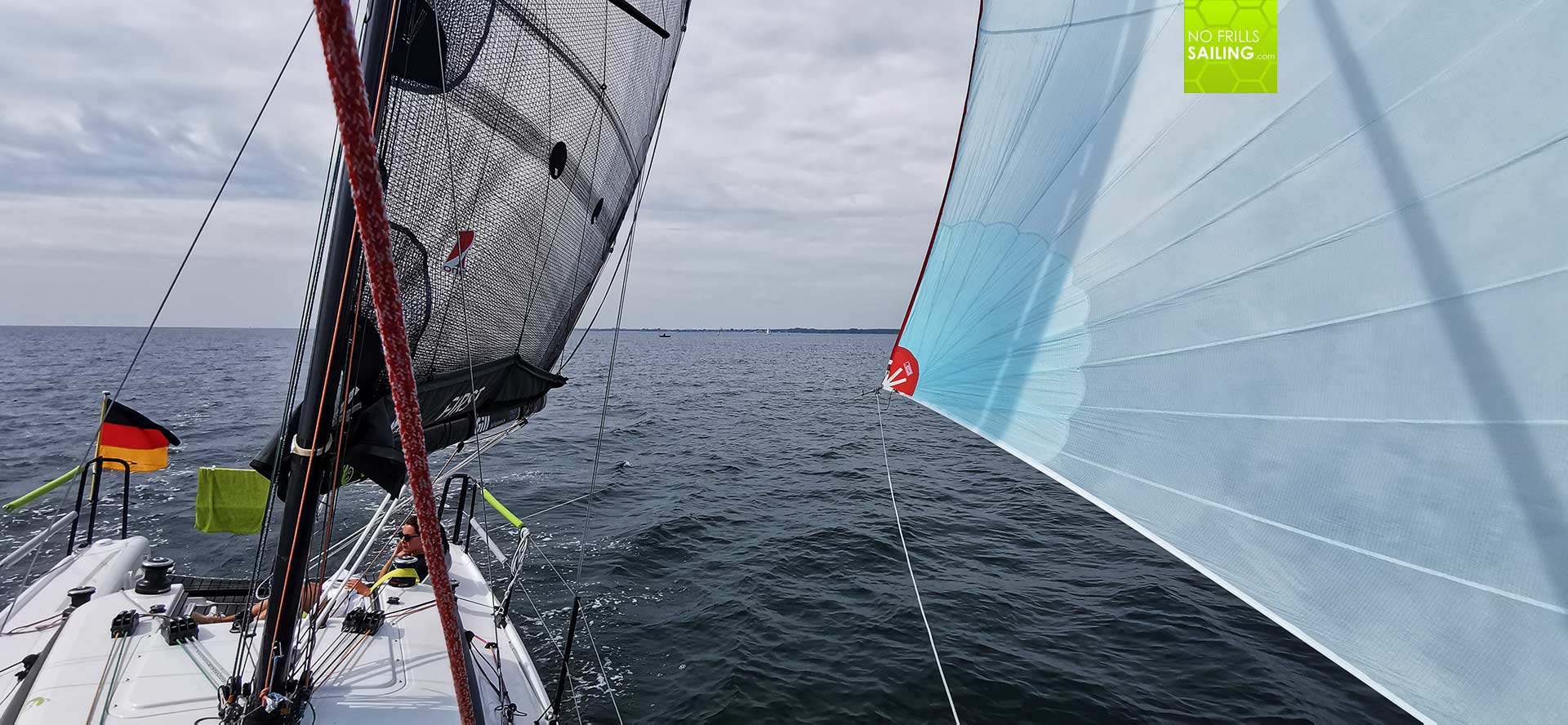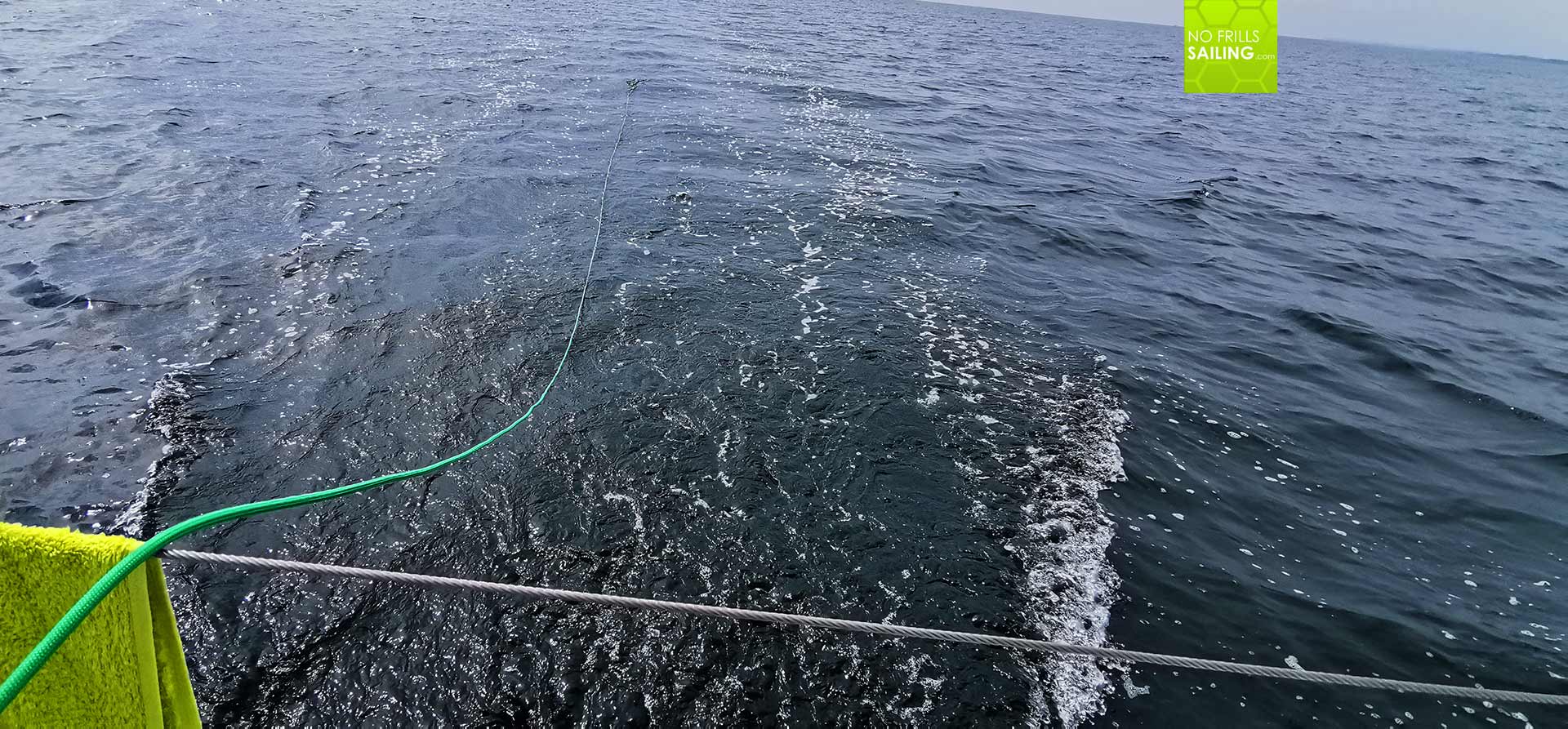It is one of the most exciting, most beautiful and most rewarding ways to sail your boat: Gennaker. I´ve just came back with GEKKO after a nice, smooth 2-week summer sailing vacation with my girlfriend and – just statistically – the numbers are convincing: Out of the 380 nautical miles we´ve been sailing all in all, some 160 miles have been done using the Gennaker. That´s more than 50 per cent of the whole trip! Now, why is a Gennaker such a thing, most first-timers and newbies to sailing might ask. Well, I can say, from my professional point of view as a boat dealer, that many rookie skippers kind of refrain from buying a Gennaker because they think its too complicated, too much hustle. It´s definitely not!

I love hoisting the kite, because it is so much fun! It is also much more efficient to use a Gennaker in light wind situations: No matter how heavy your boat, a Gennaker will power your ship even when wind speeds aren´t sufficient to make you sail under standard canvas. Since many skippers (and their families) go out in lighter conditions, it makes sense to use the Gennaker: The boring and disappointing light-wind-drifting can be avoided, the fun of sailing in lighter conditions is a sheer endless source of joy and satisfaction.

Now, when you are sailing alone, retrieving the Gennaker can be a pretty intimidating task: The sail itself seems so huge, the size and volume makes many skippers stand in awe. If you have a bigger boat, you might have fitted your Gennaker with a socket which makes retrieving as easy as ABC (read here about a Gennaker with a socket) but on smaller boats, I´d say up until 35-38 feet, your gennaker won´t come with a socket and you will have to take it down the old school way. I´ve found a pretty nice, easy and convenient way to take it in safely and after some 50 times now I feel pretty secure in executing the procedure, failure rate is down to near zero.
When it´s best to take down the Gennaker
But first: When is the best time to take down your gennaker? There are obviously two reasons to adjust your sails setup when underway. First would be a change in wind direction. A gennaker only works between 90 to 160 degrees TWD. This figure is a reasoning since the tailoring of your gennaker, measurements of the luffs can influence the range of usage, there are some gennakers capable of working at less than 90 degrees (more upwind) angles, some gennakers will allow for more downwind/running courses. But obviously, if wind direction changes too much, you will have to retrieve the sail unless you don´t want to adjust your heading.

Second reason would be an increase in wind speeds. Again, it is hard to give advice when it´s best to take in the sail. Depending on the form of your blister, spi-top or fractional gennaker, the strength of the material of the sail itself, some sails might be capable of taking on more wind speeds than others. On my First 27 SE I take the sail down when wind speeds exceed 16-18 knots TWS. Also, depending on the wind angle, I´d take it down earlier when sailing the gennaker on a beam reach and would let it stand up longer when running downwind. Also, wave heights determine when taking it in, generally, the higher the waves the earlier I´d take it down. Third, but that´s a more personal decision, depending of who sails with me: Having my kids aboard I of course reef much, much earlier. Generally speaking, the old saying applies: “If you think of maybe reefing (or taking away sail area) – do it!” And now, here is how I do it – step by step.
Step 1: Preparing the Gennaker sail bag
When deciding to take down the gennaker you will have to first prepare the boat. As I mentioned earlier, this tutorial applies to gennakers which come without the socket. So in any case you will have a sail bag to fit the gennaker. Performance-oriented boats sailed in race mode, like my First 27 SE, will have a dedicated hatch and storage facility for the gennaker. I tried this on my GEKKO and found it too complicated and error-prone so I never use the forward hatch. In crewed mode this might work, but single-handed not.

So, at first I will unleash the gennaker bag from the reeling on the bow and take it back with me into the cockpit. Now, here´s one important notice: Depending on which tack you are sailing, you want to place the bag to either port or starboard side of the cockpit. In my case (on the pictures), I was sailing the kit on port tack so I put the bag to the port side of the cockpit. Open the back, obstacle free, so that the gennaker can fit in without problems.
Step 2: Gennaker halyard over board!
First thing I´ve learned when practicing was that the single biggest problem and source of errors and failure in gennaker retrieving is the handling of the spi-halyard. In the first attempts I tried to hold the halyard (clamp open with full force of the wind!) in one hand, veering a little and trying to retrieve a little. This simply does not work – especially in higher wind speeds when there is still much pressure in the sail. So, I completely switched from “controlled veering” to “letting go at once”.

But, you know it from letting go the main sail halyard, when lines let be rolling off uncontrolled, they tend to form knots. It is pretty 100 per cent sure that you will end up having a big entanglement in front of the clamp with your kite partially down – the rest will end up in the water. Catastrophy! Now, here´s how to avoid sheet mumble. I throw the spi-halyard over board. Dragging the whole length of the rope behind will make sure it will go smoothly and unhindered through the clamp. So, you will throw the line over board and check that it is untangled completely.
Step 3: Downwind point of sail & veering the tack line
Now veer off to a near-downwind point of sail, open the mainsail halyard completely. The boat will slow down, the full size of the mainsail is now shading the gennaker from most of the wind. On my boat, with a large square top mainsail, this is more than enough to take away most of the wind energy from the gennaker. On boats with pin head mainsails you might want to sheet in the mainsail and take out the Genoa or Jib instead to shade the gennaker.

Engaging auto pilot on a near-downwind point of sail, I briefly open the clamp that secures the tackline. The tackline will be released shortly and let the gennaker go up for 1.5 metres (on my boat), again taking away some of the leftover energy of the wind that is still blowing the nylon up full size.
Step 4: Releasing halyard and working like hell!
Up until now everything was done in a controlled and calm way, no hustle, no rush. Everything goes smooth and quiet. The next step, however, is the exact opposite: You will have to work really quick and fast to retrieve the gennaker. I do it the following: I go to the coaming and grab the leeward gennaker sheet, take it and pull it towards me until I stand exactly over the sail bag. You do not release the sheet!

Next thing, after taking a deep breath, I open the spi-halyard clamp which will immediately release the halyard and make the sail come down at once – uncontrolled and very quickly! In doing so, I go down on my knees and drag the nylon down into the bag like a crazy guy.

Because of the fact that the gennaker halyard is free in the water it will run through the open clamp freely and without any problems. The gennaker will come down, dragged and pushed into the sail bag by myself working like a crazy monkey. This all will take no more than 5 seconds and – I cannot stress this too many times – if you do not act quickly, the gennaker comes down faster than you grab it, it will end up in the water. Which we do not want under no circumstances!

Be fast, be bold, be quick. Depending of how long your arms are and how you grab the nylon, you will quickly learn with every manoeuvre, that it is just that: Speed! Do not care for the sheets: Both leeward and windward sheets do not need to be adjusted in this manoeuvre, also do not care about the tackline. Just rip it down as it comes and stuff it into the bag.
Step 5: Taking back the tack-clew
If you are successful, the majority of the nylon will end up in the sail bag with the halyard clew arriving in your hands. You will end up holding the last metres of gennaker-canvas in your hand which go to the bow and to the tack-clew. Hold it under pulling pressure and stand up. Now take the tackline, put it one or two times over the winch and release the clamp.

Metre by metre you will veer the tackline and take in the remaining canvas. By that, the tack-clew will also gradually arrive directly over the sail bag. The nice thing about “my” technique (which it isn´t of course, I´ve tried it out after watching a YouTube video explaining exactly this code of conduct) that it always* works. No matter the wind speed, the wave heights or other external factors, if you respect these five steps, you will get down the gennaker safely and secure it nicely.

After all of the clews, sheet-, halyard and tack-clew, have arrived in the bag, you may want to push the whole canvas into the bag. Point is: Do not care at all for possible plaits and buckles. In my early days of gennaker sailing I took out the whole sail arrived in the next harbors and tried to fold it up “the right way” to make sure it will go up next time hoisted. Forget this! I promise that if you leave the gennaker sail in the bag stuffed the way it came down – it will go up and unfold in all its glory next time hoisted without any problems! It´s amazing to see it unfolding from chaos – and ending up in a sand clock pattern when folded nicely in the harbor. So: Never touch the sail again when having taken it down.
Having the Gennaker ready for next hoisting
Depending on your sailing trip, you may want to ready the gennaker sail again for a possible next hoisting (maybe next day). So, you can either untie the halyard and tackline, take in the sheets and pack the gennaker into the bag, tie the bag and stow it away down below or you ready the gennaker for the next hoisting. I did both during my summer trip. Here´s how.

I untie the halyard because and attach it to the mast foot again. I don´t like sailing with a loose halyard dangling in front of the Jib and possibly entangling with the Jib. All other lines will remain attached to the gennaker. I walk the bag to the bow again and fix it to the reeling. The leeward sheet is taken abaft and fixed to the dock line cleat, the windward sheet is lead abaft as well but being put under the Jib-furler so that there may not be any entanglement. I fix this sheet to the aft cleat as well. Tack clew remains connected to the line, depending of how immediate I think the next gennaker-part will set it, I either have it directly at the bow sprit tip or I retrieve the bowsprit and put the clew into the bag as well. In any case, the Gennaker is now ready to go up in a minute´s notice with just the halyard needs to be attached (also depending on the side to which the Gennaker will be hoisted to).
Retrieving the Gennaker from starboard-side
All you have been seeing on the pictures and reading in my article here is in regards to Gennaker that is hoisted on port side of the boat with the halyard clamp mounted on the starboard side. Obviously, the manoeuvre described works as well when the sail is set to the other side but with a minor change: As (on my boat) the halyard will be running over board on starbard side, you cannot sit there and take down the sail. It will end in a huge sheet mumble, the nylon getting entangled with the halyard.

Now, on one occasion during my sailing trip we´ve had exactly this situation: It was getting dark (and we sailed well into the night up until next morning 0130 a.m., wind was forecasted to change to upwind point of sail whilst increasing, so I decided to take down the Gennaker utilizing the last sunlight of the day. Of course, I could have gybed and proceeded as described, but here´s how I managed it.

I simply took the spi-halyard and diverted it over the starboard roofing winch to the portside roofing winch to let the line run overboard as described. It was now out of the way and I was free to take down the Gennaker on starboard side. Also, the two winches added some (little) extra drag to the line which made the Gennaker come down a bit slower, making the whole manoeuvre a bit safer. The rest ran as described and all went just fine. Well … except that minor errors can and will happen. Here are the most common errors in Gennaker-retrieval single handed you might encounter.
Possible sources of errors
Worst thing that can happen is the Gennaker going into the water. This is not such a big problem if it´s just a bit of the sail. As it happened during that night-retrieval: I already had the majority of the sail in the bag but didn’t grab the rest going forward to the tack. Some of the sail ended up in the water. Acting quickly I could avoid more sail in the water. This such because a wet sail when stored away down below will tend to molder.

It will be much, much more annoying and also kind of dangerous if more of the Gennaker sail is down in the water: As the boat is still making progress through the water, it will overrun the sail. Forming a sack, the sail will be filling itself with water, getting heavier, adding drag t the boat and pull more of itself into the water. Retrieving a water-filled sack of Gennaker is just the worst. Adding injury to insult, worst that could happen is that the Gennaker-sack underwater wraps itself around keel or rudder blades, which in worst case could mean to stop the boat, have her drifting and go for a dive with a knife, a possible loss of the Gennaker and maybe damage to the appendages.
No reluctance, steep learning curve
This all is not necessarily going to happen if you practice Gennaker sailing and retrieving in light wind conditions. If you are new to light wind sails-sailing, go out on a fine summer´s day, no waves, very light winds and practice hoisting and retrieving your kite. You will surely quickly learn the code of conduct and maybe encounter some difficulties, also maybe having a wet Gennaker. But that is all normal and nothing special. Then, run up your performance, do some longer distance sailing with your kite and practice. Never stop to learn.

Judging by my own learning curve, I can tell you that after some 15 to 20 times hoisting and retrieving the Gennaker I feel pretty sure and safe about my abilities. It is still very exciting and my heart beats time and again, but I very seldom encounter difficulties or make errors. You will get better and surely safer each time you do it. By that, you will become a better sailor and – utilizing the Gennaker – discover the magic of light-footed sailing in conditions when most of the heavy, standard-rigged boats will have to use their engine while you will be graciously passing by under a proud and colorful sail fully blown by a ice breeze.
You may also read these related articles:
First time Gennaker-sailing single handed on my new boat
Gennaker action on a Pogo 40 S
Preparing a Code 0 light wind sail first time
